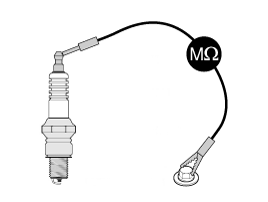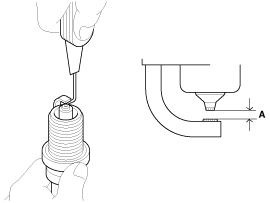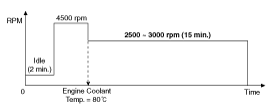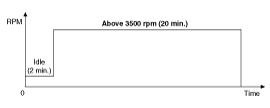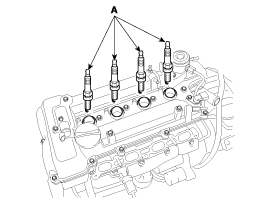Hyundai Kona: Ignition System / Spark Plug Repair procedures
Hyundai Kona (OS) 2018-2025 Service Manual / Engine Electrical System / Ignition System / Spark Plug Repair procedures
| Inspection |
[On vehicle Inspection]
| 1. |
Accelerate the engine to about 3,000rpm 3 times or more.
|
| 2. |
Remove the spark plug.
|
| 3. |
Check the spark plug visually.
If the electrode is dry, the spark plug is normal.
If the electrode is wet, check the damage and electrode gap as below.
|
[Component Inspection]
| 1. |
Check the spark plug for any damage on its thread and insulator.
If there is damage, replace the spark plug.
|
| 2. |
Check the electrode. Measure the insulation resistance with an ohmmeter.
If the resistance is less than the specified value, adjust the electrode
gap.
|
| 3. |
Check the spark plug electrode gap.
If the gap is greater than the maximum, replace the spark plug.
|
| Cleaning |
The combustion temporarily becomes unstable, due to the aged fuel and the carbon
deposits accumulated on the spark plug(s) after long-term storage.
[1st Method]
| 1. |
Start the engine and keep the engine running at idle for 2 minutes.
|
| 2. |
Step on the accelerator pedal and hold it steady at 4500 rpm with the
shift lever in N position to warm up the engine until the temperature
of the engine coolant reaches 80°C.
|
| 3. |
Keep the engine running at 2500-3000rpm in the N position for 15 minutes.
|
[2nd Method]
|
| 1. |
Start the engine and keep the engine running at idle for 2 minutes.
|
| 2. |
Drive the vehicle for over 20 minutes, keeping the engine speed above
3500rpm.
|
| Removal |
| 1. |
Remove the ignition coil.
(Refer to Ignition System - "Ignition Coil")
|
| 2. |
Using a spark plug wrench, remove the spark plug (A).
|
| Installation |
| 1. |
Install in the reverse order of removal.
|
 Spark Plug Description and operation
Spark Plug Description and operation
Description
A spark plug is a device for delivering electric current from an ignition system
to the combustion chamber of a spark-ignition engine to ignite the compressed
fuel/ai ...
 Charging System
Charging System
...
Other information:
Hyundai Kona (OS) 2018-2025 Service Manual: Rear Bumper Cover Repair procedures
Replacement
•
Put on gloves to prevent hand injuries.
•
Wh ...
Hyundai Kona (OS) 2018-2025 Service Manual: Repair procedures
Operation and Leakage Check
Check all of the following items :
Component
Procedure
Brake Booster (A)
Check brake operation by applying the brakes during a test drive. If the
brakes do not work properly, check the brake boo ...
© 2018-2025 www.hkona.com

